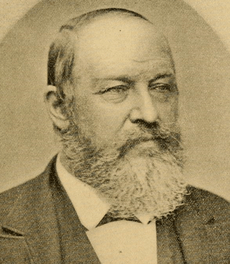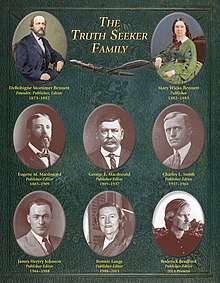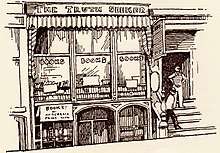The Truth Seeker
The Truth Seeker is an American periodical published beginning in 1873.[1] It was considered the most influential Freethought publication during the period following the Civil War into the first decades of the 20th Century, known as the Golden Age of Freethought. Though there were other influential Freethought periodicals, Truth Seeker was the only one with a national circulation.[1] The headquarters is in San Diego, California. The Truth Seeker is the world’s oldest freethought publication, and one of the oldest periodicals in America. Among general-readership titles, only Harper’s Magazine, The Atlantic, Scientific American, and The Nation are older.[2]
 The Truth Seeker cover dated Sept.-Dec. 2018 | |
| Editor-in-Chief | Roderick Bradford |
|---|---|
| Categories | History, secularism, censorship |
| Frequency | Triannual |
| Publisher | Roderick Bradford / The Truth Seeker Company |
| First issue | 1873 |
| Based in | San Diego, U.S. |
| Website | thetruthseeker |
Overview
In the first issue, on September 1, 1873, editor D. M. Bennett and his wife Mary proclaimed that the publication would devote itself to: "science, morals, free thought, free discussions, liberalism, sexual equality, labor reform progression, free education, and whatever tends to elevate and emancipate the human race."[1]

Subsequent editors included Eugene and George E. Macdonald,[3] Charles Lee Smith (along with his associate editors Woolsey Teller and later Robert E. Kuttner), James Hervey Johnson, Bonnie Lange,[4] and Roderick Bradford.[5] For several years, Susan H. Wixon had editorial charge of the children's department.[6]
In 1988, Madalyn Murray O'Hair put out several issues under the masthead during the course of an unsuccessful attempt to take over the company; however, the courts ruled against her ownership.[7]
Morris Altman, Mark Twain, Robert G. Ingersoll, Elizabeth Cady Stanton, Clarence Darrow, Harry Houdini, Steve Allen, Paul Krassner, and Gay Talese are or have been contributors, subscribers, and supporters of The Truth Seeker.[8]

History

Throughout its 145-year history, The Truth Seeker continuously championed freedom of inquiry, women’s rights, and Darwinian evolution, and promoted figures like Thomas Paine and Robert Ingersoll. From 1873 to about 1920, The Truth Seeker was the dominant journal of a reform movement.[2]
From 1920 until 1950 it was a journal with a proud past undergoing a slow decline. 1950 to 1988 marked its most troubled period, when the periodical embraced racism, eugenics, and anti-Semitism, but because of that achieved the smallest impact in its history. (At its peak in the late nineteenth century, The Truth Seeker’s circulation had been 50,000, yet this number dropped to fewer than 400 during the dark years.)[2]
After 1988, the bigoted content never recurred. Production values increased. From 1989 to 1998 The Truth Seeker was a wholly respectable publication, if one whose editorial focus was sometimes uncritically inclusive. This policy continued until 2013, albeit with an irregular publishing schedule. Since 2014 The Truth Seeker has been under a new editor, Roderick Bradford, and under the ownership of the Council for Secular Humanism. The Truth Seeker’s new editorial commitment looks back to the title’s greatest years of impact and significance.[2]
References
- Susan Jacoby. Freethinkers: A history of American Secularism. New York, NY: Metropolitan Books. pp. 155–156.
- "The Tale of The Truth Seeker".
- "George E. Macdonald". ffrf.org.
- "Truth Seeker Journal of Freethought Since 1873". truthseekerjournal.com. Archived from the original on 2 April 2012. Retrieved 23 July 2015.
- "Contact Us - The Truth Seeker". thetruthseeker.net.
- Willard, Frances Elizabeth; Livermore, Mary Ashton Rice (1893). A Woman of the Century: Fourteen Hundred-seventy Biographical Sketches Accompanied by Portraits of Leading American Women in All Walks of Life (Public domain ed.). Moulton.
- "Jackson v. Truth Seeker Co., Inc., 884 F. Supp. 370 - Dist. Court, SD California 1994".
- http://thetruthseeker.net